I apologize to my readers for the break in providing content for this substack: it is lambing season. I had prepared two articles in advance to free up time for this busy season, but they weren’t enough so last week was silent. In an effort perhaps to beg excuse, I am going to share my 2023 spring lambing experience, to edify my readers a bit about what is involved.
(Bred ewes three months ago, pre-shearing. Late lambing also permits us to shear a month before lambing, making it easier for lambs to latch on to their moms, and for moms to see and nurture their babies.)
We have raised sheep for over two decades now. We started with a small flock of Corriedales, which are a dual purpose breed—wool and meat. The market for wool has not been very profitable, but the meat market for lamb has improved greatly as more customers have become aware of the benefits of grass-fed meats, and also many people want to know the animals they eat were treated humanely and not exposed to antibiotics. The market price for our lambs in 2000 was $2.40/pound. Now farmers are getting $8-10/pound! We have shifted to Dorsets, a meat breed, though we still have some Corriedale remnant blood lines in our flock (the pink-nosed sheep are pure Dorsets: those with black noses are “Corries” or Corrie crosses).
(Shorn ewes lining up like train cars, their bags and bellies swollen with fertility.)
I should note that this price inflation is not confined to meat: when we started we made our own hay, and sold bales for $2: those same bales are now $4-6 or more. Organic grain and mineral prices have tripled, and taxes and farmland have spiked. However, the overheads have not risen as quickly as the market price. The margins are still meager, but at least we are in the black.
Allow me to explain the reference to grain. Our lamb and beef are grass-fed, and the beef cows get no grain except on occasion to accustom them to be led to new pastures, or for medical care or freshening (giving birth). It is almost an art to grow fat animals with grass alone, requiring high quality feed consistently, routine rotation in pastures, and a keen eye for parasites. But in the case of the sheep, we grain them briefly twice a year.
First, we grain the ewes for about two weeks before we release our breeding ram to join them. This “flushing” provides the girls with abundant nourishment, increasing the likelihood that they will drop more eggs in estrus and have twins or triplets. We breed late season so that we have fewer mortalities. We have lambed for decades in the Northeast Kingdom, where temperatures in winter plummet to as low as 40 degrees below zero, increasing lambing losses, or “lambsicles” as we call them. So rather than lamb in February, we hold the ram back until December and lamb in May. The sheep get a bit of grain before breeding, and then only hay and minerals through April.
(Week-old twins: a ram and a ewe.)
About two weeks before the lambs are due, we grain the ewes again. This improves milk production and ensures the moms have all they need nutritionally. It also reduces the likelihood of delivery complications, especially retained placentas. Generally speaking, cows are much hardier than sheep, and these problems are much less common in bovines. Once the girls deliver, or “freshen,” we continue to grain them through their lactation. Especially if they have triplets, the drain on their bodies is tremendous, increasing as the lambs (very quickly) grow to weaning age at about two months old. Then it’s back to grass only.
Part of the annual lambing ritual for us is removing the bedding “hardpack” from the winter. This refers to the accumulated hay bedding we use to keep the sheep warm, and to prevent mastitis and hoof rot. We kept our ewes in an outbuilding this year (that they barely used, preferring to lay outdoors), but last year’s lambs were housed in the small barn/garage off the house. By May, this pack of hay was about two feet deep, saturated with urine and feces, and meshed together in a tight, wet weave. This is the same area where we like to move the new mothers with their lambs when they are born, so it had to be cleaned out.
(Hardpack bedding, with manure and urine already composting the mass. It comes out mostly in heavy slabs. This creates the organic foundation for our vegetable garden.)
This was the bigger reason for my substack hiatus—pitchforking out about 12 heaping truckloads of manure/hay, which I then transported to our nearby off-grid house to layer over the garden. This is an annual Herculean ritual for this humble writer. By spring I’m generally out of shape, and tearing apart and heaving hardpack is an extraordinarily arduous effort (though excellent for heart health and weight loss!). The small building is inaccessible to tractors or other equipment, so it’s old-school for me.
This year it took me eight straight days battling the pile, rushing to get it done while nervously watching the ewes for signs of labor. I was late this year because I had recorded the audio version of my upcoming book, which took four straight days in the first week of May, and set me behind. I managed to get the manure all moved the day after the first two ewes delivered twins, but we created stalls for them elsewhere pending the cleanout.
And then the lambs came in force. Following the two sets of twins, we had two sets of triplets in one day, then another set of twins and a single, then three sets of twins in one day. We have 14 ewes bred, of which twelve have now successfully delivered: a sweet girl delivered a massive single ewe lamb this morning, delivered her placenta successfully, and is doing well.
(This morning’s newborn ewe lamb…)
Sheep will mostly do well freshening on their own. I have friends in Ireland with a flock of 600 ewes, and they drop their young in the field. But even there they routinely “assist” the mothers. Teats are usually plugged and benefit from being opened for the babies, and squirting a bit of milk on their noses or into their tiny pink mouths gives them an instinctive hint. Drying them off helps reduce chill (we had a hard frost last week). Often there are lambs who can’t find the teat or have other problems, and usually we bottle feed at least one. (This year there is a triplet lamb who isn’t thriving, and Jackie gives him a bottle of Jersey milk two or three times daily as supplement, but he is still on Mom and hopefully will get the hang of it).
To reduce mortality and help the sheep, we separate the newborns and their mothers out initially unless they are singles, so they can become firmly bonded. We have 24 lambs as of this morning, and it can be a chaotic cacophony when they are constantly running around in panic trying to figure out who’s who. Mothers can also be quite brutish toward lambs not their own. We construct temporary stalls using free discarded pallets tied together with used baling twine. After a week or two we will let everyone out to pasture together, a delightful experience for all.
We are not out of the freshening woods yet, but so far we have had no mortalities of either ewes or lambs, and no retained placentas or mastitis. This has been a very exhausting but blessed season. As farmers know especially well, worthwhile achievements always involve hard work. There would be no gratitude and satisfaction in animal husbandry without the adversity and challenges, as in life in general.
Some people might wonder why we bother with lambs. As my upcoming book explains, reducing or avoiding grains is a good way to reduce pollution from the fossil fuels used in their production. It is also a way to remove or reduce that monetary expense as a hedge against inflation. Chickens and pigs are highly dependent on factory grains, but beef and sheep can survive on grass alone, just as the colonial farmers who settled in Vermont used. For preppers, sheep are also practical because they are easier to slaughter (cows are a tad heavier), twin regularly, and provide a manageable amount of meat for processing and consumption. But also, we love to eat lamb and mutton.
No one enjoys slaughtering animals, a substack perhaps for a future installment. But drying a lamb off at birth, rearing it, and then humanely taking its life for food is what most human cultures have done for tens of thousands of years. There is a reverence and gratitude and humility involved that is eliminated by the industrial food system. Americans waste a lot of food, largely because they see it as cheap and disposable. No reverence.
The American food supply has become a hellish, profit-driven horror for most meat production. Animals are crammed together, necessitating antibiotics; fed body parts of other animals (cows are fed cow body parts); and then slaughtered in a callous, industrial factory that would make horror movies look like children’s la-de-da fairytales.
Anyway, that is my excuse for the recent gap in emails to you, dear reader. I trust you will forgive me for the pause, and I promise to get back to work on writing. Though, there is fencing to be repaired, and the cows will calve soon.
And looking out the window, I think we have another plump ewe preparing to freshen—let us pray she has a smooth delivery, and that all is well……
Stay tuned!





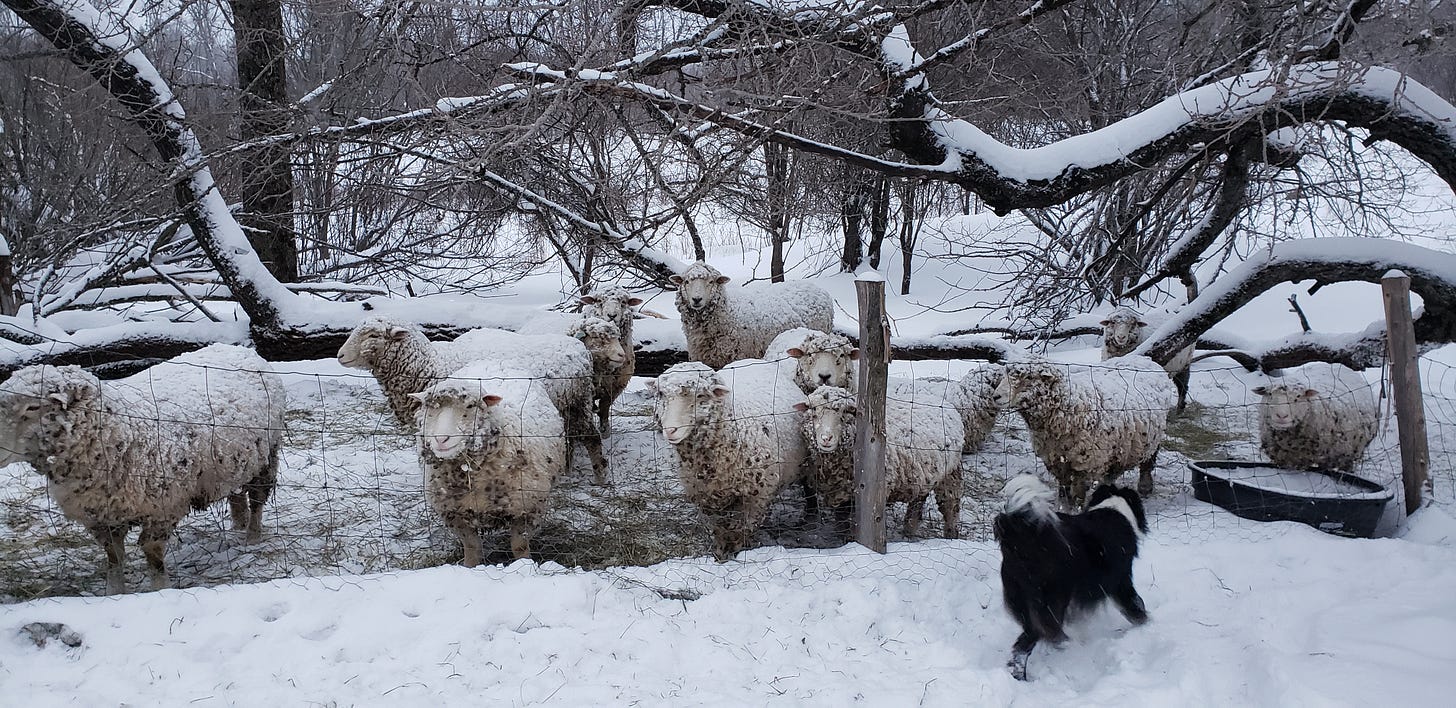
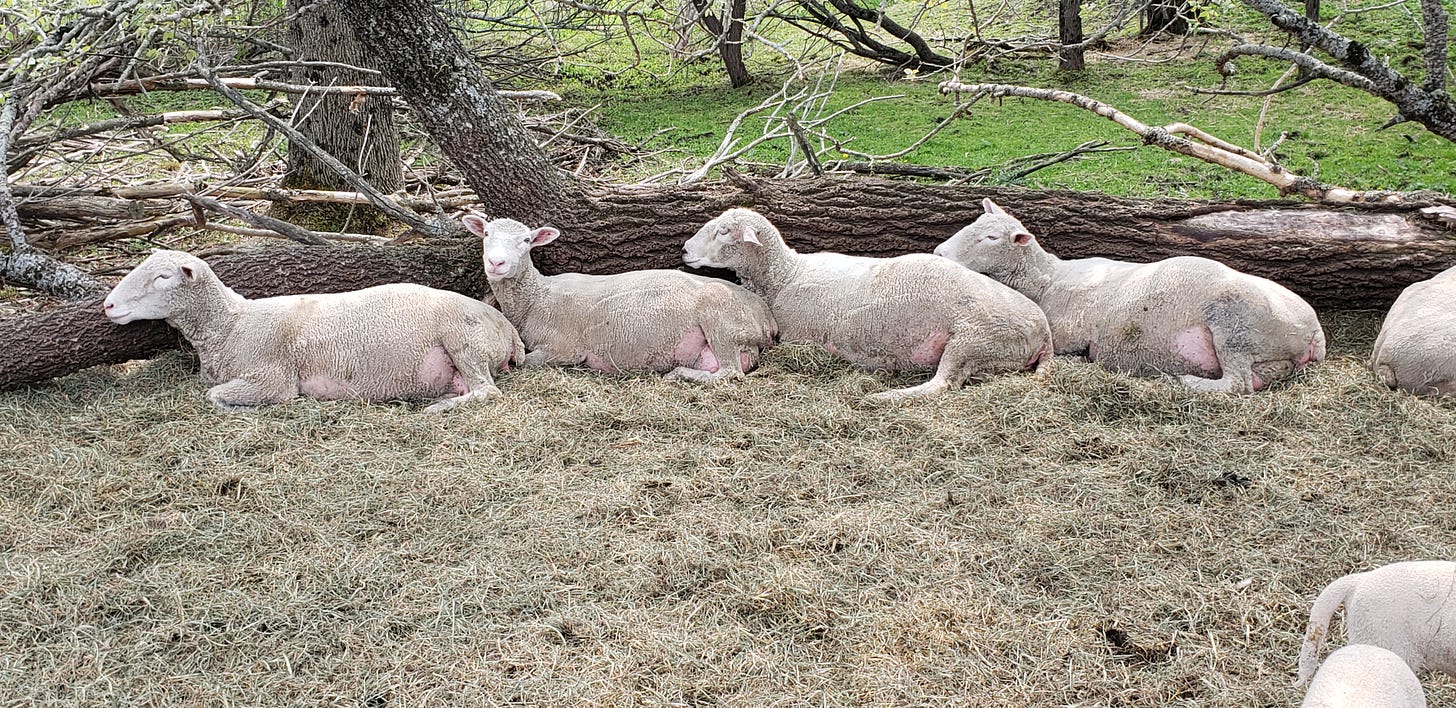
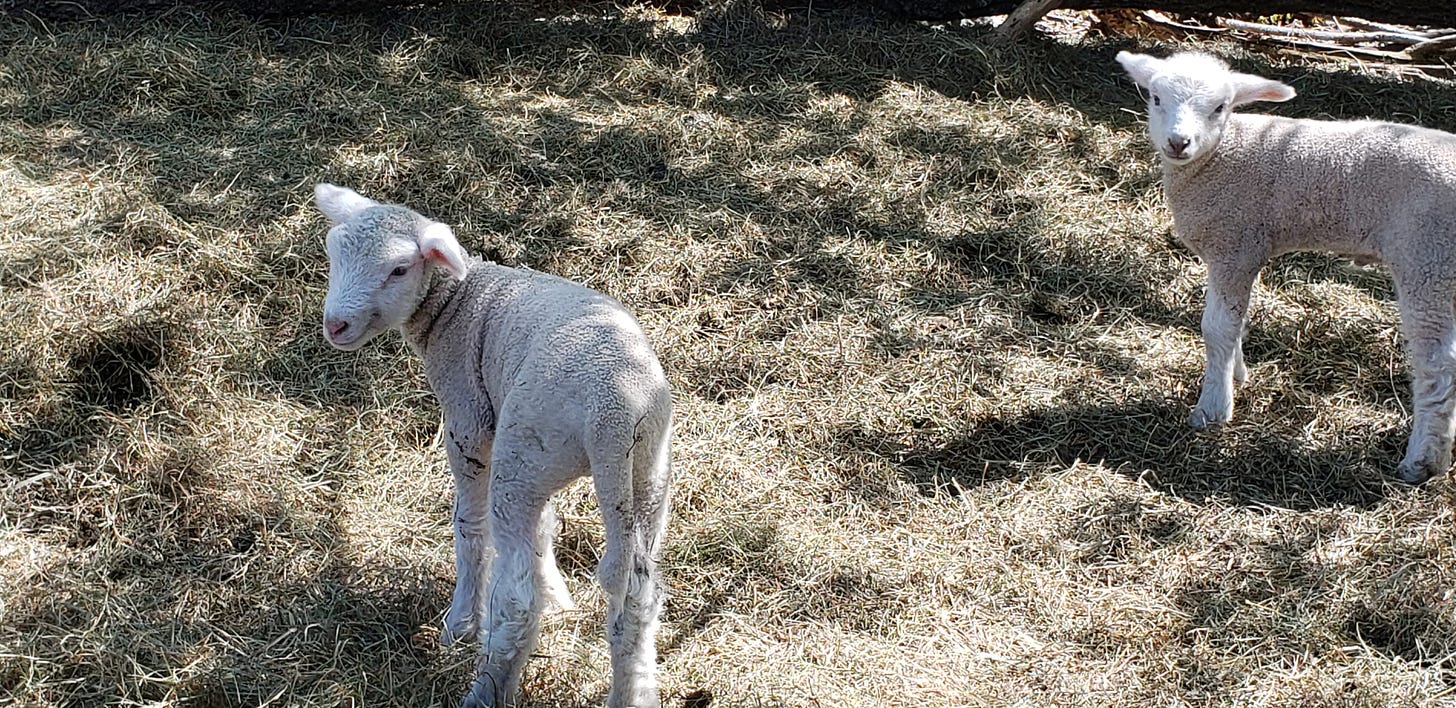
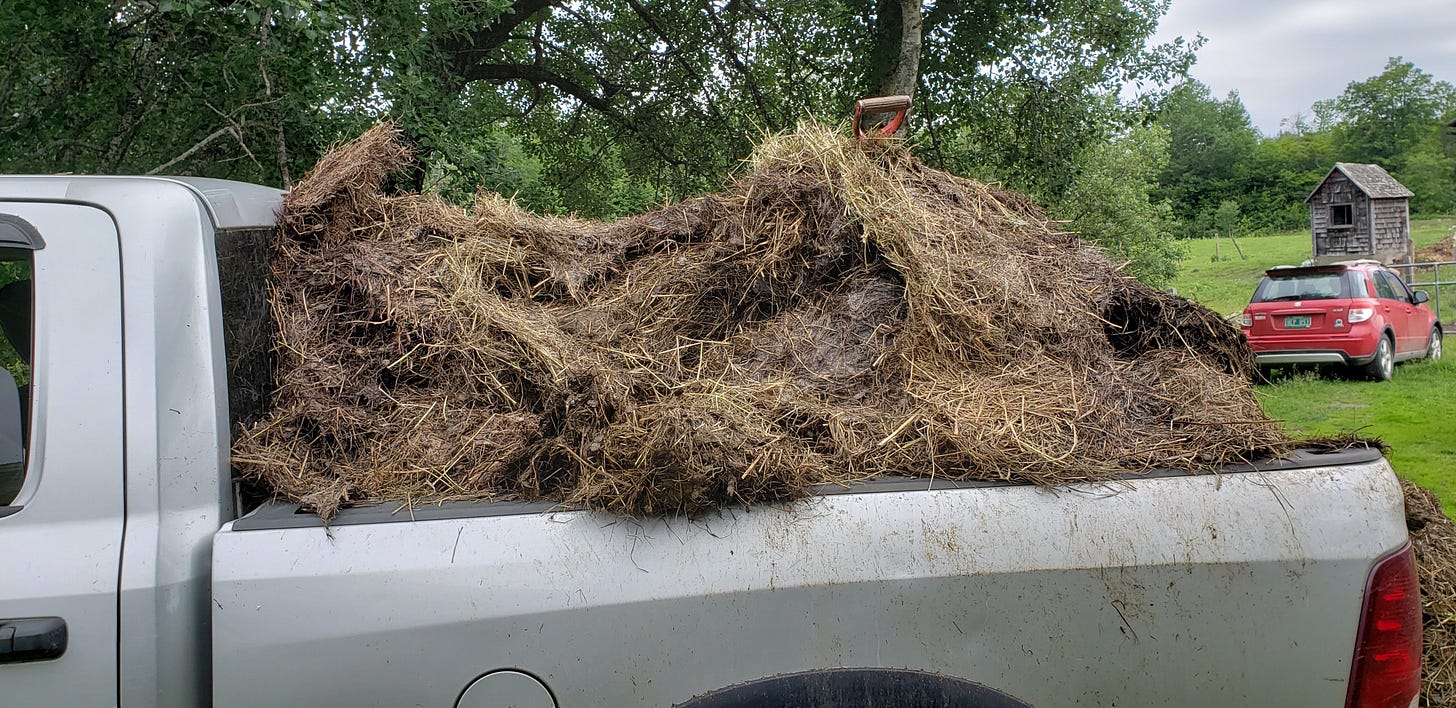
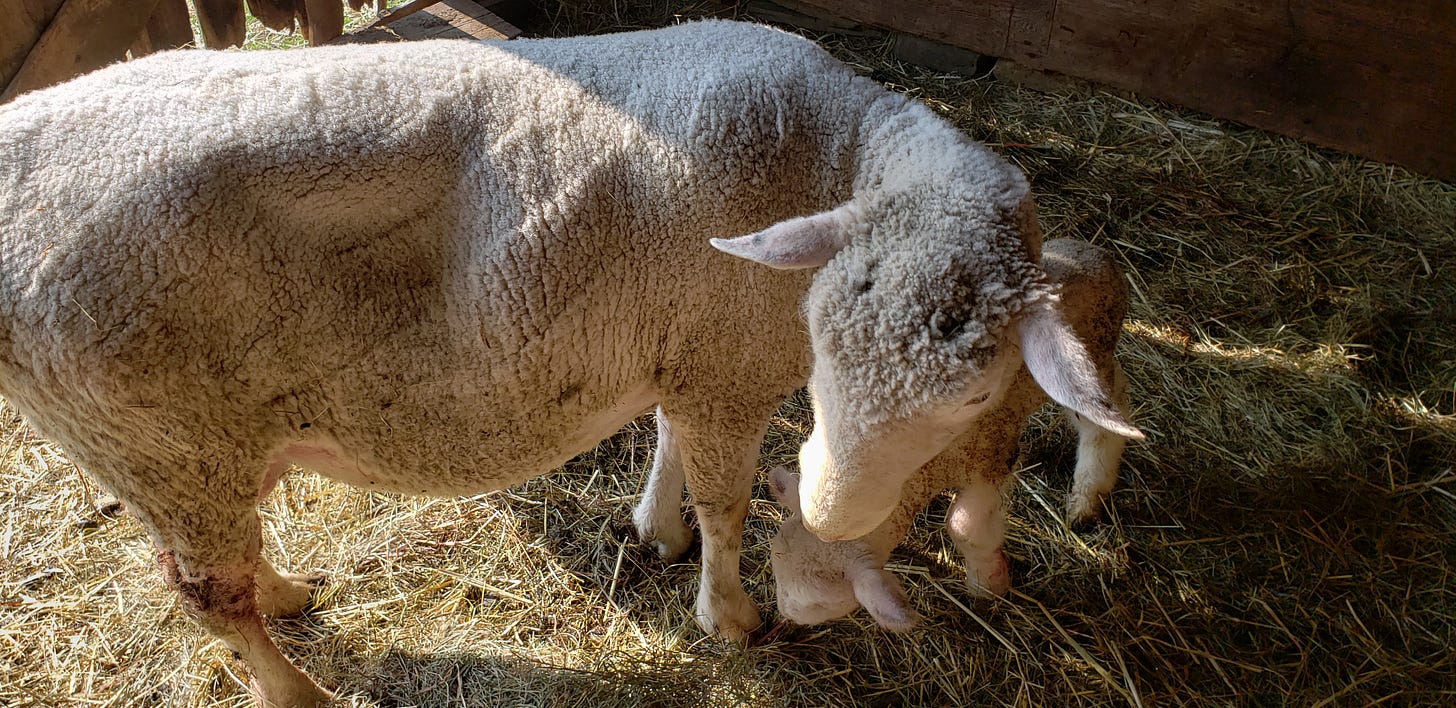
I was reliving my lambing experiences of early 1980s, when I worked on a ranch in Colorado. Lambs are so precious and funny how they dance and race around in groups, jumping and twisting. Thanks for this wonderful insight as to your farming chores. These are the best stories for me!!
So glad to hear you do late season freshening, I subscribe to the likes of Pharo cattle company philosophies and constantly shake my head at farmers/ranchers that calve in the ‘middle of winter’ and all the problems that go along with it, the more you can work with nature the easier everything works for you